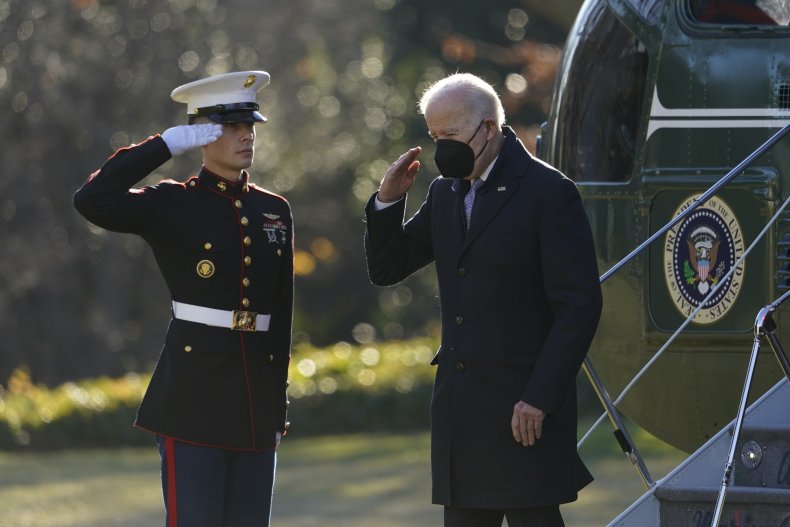A new U.S. rule issued Monday will require all new vehicles to deliver 40 miles per gallon by 2026 amid the Biden administration's ongoing efforts to tackle climate change. The regulation from the Environmental Protection Agency will replace a looser rule finalized by the Trump administration last year.
Under the new rule, mileage standards would be raised beginning in the 2023 model year so that new vehicles could hit the 40 mpg target by 2026. The Trump administration-era rule targeted raising vehicle mileage standards to 32 mpg by 2026.
The Biden administration's goal is 25 percent higher than that of his predecessor, and 5 percent higher than an August proposal from the EPA.
"These standards are the strongest vehicle emissions standards ever established for the light-duty vehicle sector, and are based on sound science and grounded in a rigorous assessment of current and future technologies. The updated standards will result in avoiding more than 3 billion tons of GHG [greenhouse gas] emissions through 2050," the EPA said in a summary of the rule.
EPA Administrator Michael Regan said that the new rule was "a giant step forward" for President Joe Biden's climate goals.
"We are setting robust and rigorous standards that will aggressively reduce the pollution that is harming people and our planet – and save families money at the same time," Regan said in a statement.

The move comes a day after Democrat Joe Manchin delivered a potentially fatal blow to Biden's $2 trillion social and environmental policy bill, jeopardizing Democrats' agenda and infuriating the White House. The West Virginia senator said he could not support the sweeping bill, which includes a host of climate proposals, saying it was too expensive and could spark inflation and expand the growing federal debt.
The now-stalled bill includes a $7,500 tax credit to buyers to lower the cost of electric vehicles.
The mileage rules being announced Monday are the most ambitious tailpipe pollution standards ever set for passenger cars and light trucks. The standards raise mileage goals set by the Trump administration that would achieve only 32 mpg in 2026. Biden had set a goal of 38 miles per gallon in August.
The standards also will help expand the market share of zero emissions vehicles, the administration said, with a goal of battery electric and plug-in hybrid vehicles reaching 17 percent of new vehicles sold in 2026. EVs and plug-in hybrids are expected to have about 7 percent market share in 2023.
The EPA said the rule would not only slow climate change, but also improve public health by reducing air pollution and lower costs for drivers through improved fuel efficiency.
Biden has set a goal of cutting U.S. greenhouse gas emissions by at least half by 2030 as he pushes a history-making shift in the U.S. from internal combustion engines to battery-powered vehicles.
He has urged that components needed to make that sweeping change—from batteries to semiconductors—be made in the United States, too, aiming for both industry and union support for the environmental effort, with the promise of new jobs and billions in federal electric vehicle investments.
While ambitious, the new standards provide adequate lead time for auto manufacturers to comply at reasonable costs, the administration said. EPA's analysis shows the industry can comply with the final standards with modest increases in the numbers of electric vehicles entering the fleet.
Auto makers continue to invest in and develop zero-emissions vehicles to meet rising consumer demand, while making public commitments to build these vehicles in the future, the EPA said. As tailpipe-pollution standards get stronger over four years, sales of EVs and plug-in hybrid vehicles will more than double, the administration projected.
Environmental and public health groups mostly hailed the new rules, while the trade association representing most major automakers reacted cautiously.
Automakers are "committed to achieving a cleaner, safer, and smarter future,'' but EPA's final rule for greenhouse gas emissions is more aggressive than originally proposed, "requiring a substantial increase in electric vehicle sales, well above the 4 percent of all light-duty sales today,'' said John Bozzella, president and CEO of the Alliance for Automotive Innovation. The group represents manufacturers producing nearly 99 percent of new cars and light trucks sold in the U.S.
"Achieving the goals of this final rule will undoubtedly require enactment of supportive governmental policies – including consumer incentives ... and support for U.S. manufacturing and supply chain development," Bozella said in a statement.
EPA called the new rule critical to address climate change. Transportation is the single largest source of greenhouse gas emissions in the United States, making up 29 percent of all emissions. Within the transportation sector, passenger cars and trucks are the largest contributor, accounting for 58 percent of all transportation-related emissions and 17 percent of overall U.S. carbon emissions.
The final standards will contribute toward a goal set by the 2015 Paris climate agreement to keep the increase in the global average temperature to well below 2° Celsius above pre-industrial levels, the EPA said. The U.S. rejoined the Paris agreement on Biden's first day in office after former President Donald Trump had withdrawn the U.S. from the global pact.
The new rules would begin with the 2023 car model year and increase emissions reductions year by year through model year 2026. The rule accelerates the rate of emissions reductions to between 5 and 10 percent each year from 2023 through 2026, the EPA said, far higher than under previous rules.
The Associated Press contributed to this report.


Post a Comment